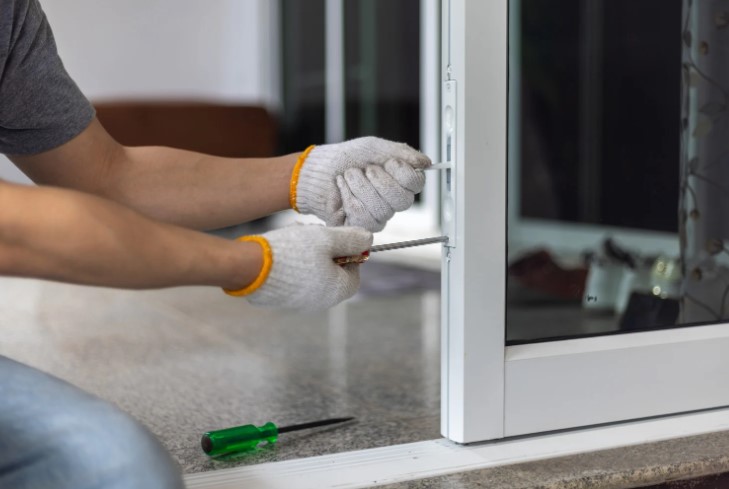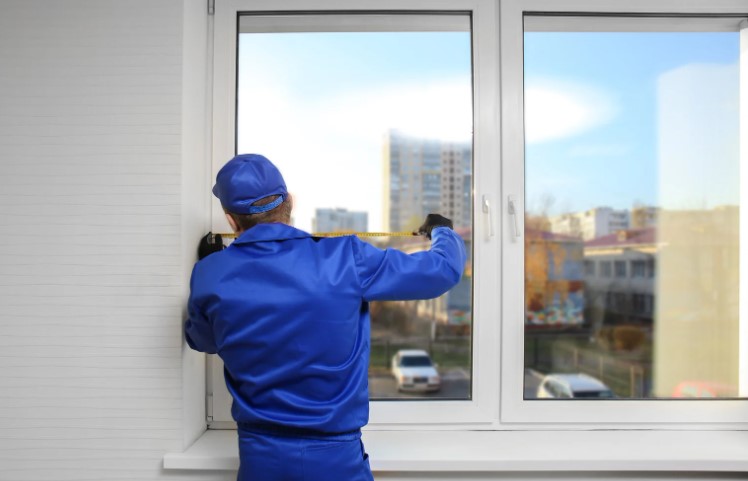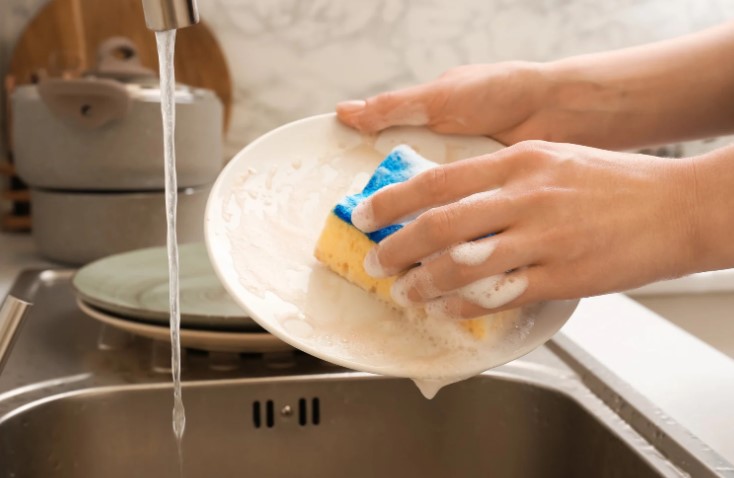
by Kanimozhi BV | Jul 30, 2025 | Window, DIY Ideas, Home & Living, Interior
Ever twisted your window handle only to feel it turn freely without anything happening?
It’s a frustrating situation—especially when you’re trying to let in fresh air or cool down a room. I’ve had to deal with this problem myself, and it’s surprisingly common.
Let me guide you through what I discovered about why the window handle moves but window won’t open, and how I fixed it safely and effectively.
Why Does window handle moves but window won’t open happen?
When the handle rotates but the window stays firmly shut, it’s usually a sign that something has gone wrong inside the locking mechanism or frame alignment.
This can occur in both old wooden frames and modern uPVC double-glazed windows. Whether the issue is a faulty gearbox, a stuck espagnolette, or a jammed gasket, understanding the inner workings is key to resolving it.
What could cause a stuck window handle or jammed lock mechanism?
Several factors can stop the window from opening even though the handle seems fine:
- Dried or stuck rubber seals: Over time, rubber gaskets can adhere to the frame, especially after long periods of inactivity.
- Dust, grit, or corrosion: Debris lodged in hinges or locking points can block movement.
- Worn spindle inside the handle: The metal bar that connects the handle to the internal mechanism can wear down or slip out of alignment.
- Broken gearbox: The internal part that engages the locking rods may be broken or disconnected.
- Warped sash: The frame of the window may have become misaligned due to temperature or poor installation.

How can I check if the gearbox or espagnolette mechanism is faulty?
To check for internal problems, I removed the handle carefully using a screwdriver and inspected the spindle. If it’s not engaging with anything inside, the gearbox could be broken. I also looked for signs of rust or misalignment.
Here’s a quick test:
- Disconnect the handle and try to rotate the exposed spindle with pliers.
- If there’s no resistance or clicking, the gearbox may be at fault.
- Seek for any signs of harm around the locking points of the window.
What DIY methods might open the window without damaging it?
I tried a few safe methods to get my window open without resorting to breaking it:
- Unstick the gasket: I slid a plastic card or scraper between the sash and frame to release the rubber seal.
- Manually release the locks: With long-nose pliers, I gently turned the cam or bolts inside.
- Tilt & Turn windows: For these, I pressed the spring release button and reoriented the handle to reset the mechanism.
⚠️ Be cautious: apply even pressure and avoid forcing anything abruptly to prevent damage.
When should I replace the handle or gearbox entirely?
In my case, the spindle had worn down, and the handle wasn’t engaging the mechanism. If your window behaves similarly, it might be time for a replacement. Here’s a simple checklist:
| Component |
Replace If… |
| Handle |
Spindle is loose, stripped, or broken |
| Gearbox |
No movement in mechanism even when spindle is turned manually |
| Espagnolette bar |
Bent, stuck, or not extending |
Costs are generally affordable:
- New handle: £8–£20
- Gearbox: £15–£35
- Professional fitting: Around £40–£60 depending on the location

How can I prevent this issue recurring?
To avoid facing the same situation again, I’ve started doing the following:
- Regular lubrication: I use silicone spray on the hinges and locking points every few months. Stay away from WD-40, as it may degrade uPVC over time.
- Window Cleaning: Dust and debris are major culprits. I clean up the seals and hinges using a gentle cloth and mild detergent.
- Check alignment: I look out for signs that the sash is dropping or not closing evenly. In such cases, realigning with heel-and-toe adjustment helps.
Here’s a handy table of tools I used and what you might need too:
| Task |
Tools or Resources |
| Remove handle |
Phillips screwdriver, craft knife |
| Inspect gearbox |
Long-nose pliers, flashlight |
| Lubricate hinges |
Silicone spray, dry cloth |
| Replace parts |
Matching handle/gearbox set, measuring tape |
| Call for help |
Local window technician or handyman |
Why did the issue happen on specific types like UPVC or tilt & turn windows?
In uPVC windows, the espagnolette mechanism is a common point of failure. If the internal rods or shoot bolts don’t move when the handle is turned, the gearbox may be jammed.
For tilt and turn windows, the issue often comes from improper handle positioning—if the handle is turned before the sash is fully closed, the mechanism locks up.
I learned the hard way that patience and precision are crucial when operating these window types.

Conclusion
Dealing with a window that won’t open even though the handle turns can be annoying—but it’s rarely unfixable. Whether it’s a sticky seal or a faulty lock, identifying the issue early can save you time, money, and stress. Here’s a quick summary of my tips:
- Inspect the handle and spindle for signs of wear
- Use gentle tools to release stuck gaskets
- Check the gearbox and espagnolette mechanism
- Lubricate regularly to prevent future issues
- Replace damaged parts promptly
Don’t be afraid to call a pro if window handle moves but window won’t open—but many of these fixes are simple enough to do yourself.
Related Article: How to Clean uPVC Window Frames? – A Step-by-Step Guide

by Kanimozhi BV | Jul 28, 2025 | Garden, Exterior
I’ve always been drawn to the cheerful simplicity of daisies, but I often want a little more colour and variety without compromising on ease.
That’s why I love planting daisy like flowers — low-maintenance alternatives that deliver the same classic look but thrive in our unpredictable UK climate.
Whether your garden is full of clay, gets too much rain, or sees limited sun, these blooms will reward you with long-lasting colour, bee-friendly petals, and very little fuss.
Here are my top 10 easy-growing daisy alternatives that blend beautifully into British gardens and work well in borders, containers, or wild-style beds.
🌸 Top 10 Easy-Growing Daisy Like Flower for UK Gardens
If you’ve ever wondered “what flowers look like daisies but are easy to grow in my climate?”, this list is for you. Below are ten reliable favourites that deliver daisy-shaped blooms, vibrant colour, and low-effort care in the UK garden.
🌼 1. Shasta Daisy (Leucanthemum x superbum)
A garden classic. These bold, white-petalled perennials look just like traditional daisies — only bigger.
- Height: 60–90 cm
- Bloom Time: June–September
- Sun: Full sun
- Soil: Well-drained
- Care Tip: Deadhead regularly for continued blooms.

🌻 2. Black-Eyed Susan (Rudbeckia)
Golden petals and a dark centre give this plant a warm, late-summer vibe.
- Height: 45–90 cm
- Bloom Time: July–October
- Sun: Full or part sun
- Soil: Loamy or clay
- Care Tip: Divide every 3–4 years for stronger plants.

🌺 3. Coneflower (Echinacea)
With its upright growth and conical centres, it’s a standout in bee-friendly planting.
- Height: 60–120 cm
- Bloom Time: July–September
- Sun: Full sun
- Soil: Sandy or well-drained
- Care Tip: Leave seed heads over winter for birds.

🌼 4. Coreopsis (Tickseed)
Small, sun-loving plants with cheerful yellow or red daisy-like blooms.
- Height: 30–60 cm
- Bloom Time: June–August
- Sun: Full sun
- Soil: Poor or sandy soil
- Care Tip: Drought-tolerant and great for borders.

🌾 5. Oxeye Daisy (Leucanthemum vulgare)
A wildflower that brings a natural meadow feel to your borders.
- Height: 40–80 cm
- Bloom Time: May–August
- Sun: Full or part sun
- Soil: Most types
- Care Tip: Allow to self-seed in informal beds.

🌷 6. Aster
Known for showing late-season colour in shades of pink, purple & white.
- Height: 30–90 cm
- Bloom Time: September–October
- Sun: Partial sun
- Soil: Moist but well-drained
- Care Tip: Cut back in early spring for shape.

🔥 7. Gaillardia (Blanket Flower)
This fiery flower adds a burst of red and yellow to dry spots.
- Height: 30–60 cm
- Bloom Time: June–September
- Sun: Full sun
- Soil: Sandy, well-drained
- Care Tip: Great in rockeries or coastal gardens.

💗 8. Erigeron (Fleabane)
Delicate daisy blooms in pink-white that spill beautifully over edges and walls.
- Height: 15–30 cm
- Bloom Time: May–October
- Sun: Full sun
- Soil: Any free-draining
- Care Tip: Shear mid-summer to refresh growth.

💊 9. Feverfew (Tanacetum parthenium)
Miniature daisy flowers with herbal heritage — compact and cheery.
- Height: 30–60 cm
- Bloom Time: June–September
- Sun: Full or part sun
- Soil: Well-drained
- Care Tip: Deadhead to prolong flowering.

🌼 10. Marguerite Daisy (Argyranthemum)
Lovely for pots and patios with soft pastel daisy-like flowers.
- Height: 30–50 cm
- Bloom Time: June–September
- Sun: Full sun
- Soil: Rich, well-drained
- Care Tip: Feed regularly; protect from frost.

Which Daisy Lookalike Is Right for Your Garden?
Here’s how I match daisy-like flowers to different garden conditions:
Best Picks by Garden Type
- For late summer blooms: Rudbeckia, Aster
- For containers or small spaces: Erigeron, Marguerite
- For pollinator appeal: Echinacea, Shasta Daisy
- For dry, hot spots: Coreopsis, Gaillardia
- For naturalised or wild areas: Oxeye Daisy, Feverfew
🌼 Final Thoughts
Adding a mix of daisy like flowers has completely transformed my garden. They offer long-lasting blooms, attract pollinators, and demand very little from me in return.
If you’re after colour, structure, and wildlife value with low maintenance — these flowers are a winning choice for any UK garden.
Related Article: Inexpensive Raised Garden Bed Ideas – DIY Cheap Solutions UK

by Kanimozhi BV | Jul 28, 2025 | Exterior, Garden
As a UK gardener, I used to wonder: is compost the same as soil? They both look earthy, smell natural, and seem essential in the garden.
But over time, I discovered they serve very different purposes. Understanding these differences helped me grow healthier plants, enrich poor soil, and make smarter gardening choices overall.
What Exactly Is Compost?
Compost is decomposed organic material. It’s made from kitchen scraps, garden waste, and other biodegradable matter.
Over time, bacteria, fungi, and worms break this matter down into a nutrient-rich material that boosts plant health.
When I compost at home, I usually add:
- Fruit and vegetable peelings
- Grass clippings and leaves
- Coffee grounds and eggshells
Once matured, compost becomes a dark, crumbly substance that smells earthy. It’s packed with beneficial microbes and nutrients, making it ideal as a soil amendment, not a full substitute for soil.

What Makes Up Garden Soil?
Soil is a natural mixture of minerals, organic matter, water, and air.
Unlike compost, which is manually created, soil forms over thousands of years through the breakdown of rocks and organic materials.
In the UK, we commonly encounter:
- Clay soil – dense, slow-draining but nutrient-rich
- Sandy soil – light, well-draining but poor in nutrients
- Loamy soil – the ideal mix of sand, silt, and clay
Each type has its quirks, but compost can improve all of them. Mixing compost into my heavy clay soil has done wonders for drainage and root growth.
Compost vs Topsoil: What’s the Real Difference? Is Compost the Same as Soil?
Many gardeners confuse topsoil with compost. Let’s break down the distinctions:
| Feature |
Compost |
Topsoil |
| Origin |
Decomposed organic matter |
Naturally occurring upper soil |
| Nutrients |
High in organic nutrients |
Moderate, varies by location |
| Texture |
Loose, crumbly |
Denser, depends on soil type |
| Purpose |
Soil enhancer |
Planting base |
| Best Use |
Soil improvement, mulching |
Lawn seeding, garden beds |
I use compost to enrich my garden beds and topsoil when I need to level out lawn patches or create new planting areas.

Should I Use Compost Instead of Soil?
No, compost isn’t a direct replacement for soil. While it’s packed with nutrients, compost lacks the structure needed for root stability and moisture retention.
I’ve found that pure compost dries out too quickly and may overwhelm delicate seedlings with nutrients.
Instead, I mix compost with soil—typically in a 1:1 or 1:2 ratio—depending on the plant’s needs.
Can You Use Compost as Topsoil?
Sometimes, yes—especially when dealing with poor or damaged soil. I often spread compost as a top layer on my garden beds to improve the existing soil’s quality. This is known as top dressing.
But if you’re laying new turf or filling garden beds from scratch, start with topsoil and then work compost into it for better results.
Should I Use Soil or Compost?
Here’s a quick breakdown of when I choose one over the other:
- Use Compost for:
- Soil enrichment
- Mulching around plants
- Boosting raised bed fertility
- Use Soil for:
- Filling garden beds
- Lawn base
- Potting large plants

Which Is Better, Soil or Compost?
Neither is “better”—they serve different roles. Compost improves soil health, but it can’t replace it. Soil supports root structure, but on its own, it might lack nutrients.
Together, they create the perfect environment for plants to thrive.
Which Plants Don’t Like Compost?
Not all plants enjoy compost-rich environments. I avoid using compost around:
- Lavender, thyme, and other Mediterranean herbs (they prefer dry, lean soil)
- Native wildflowers, which often thrive in poor soil
- Cacti and succulents, which need fast-draining soil with minimal organic matter
Knowing these exceptions helps me avoid overfeeding plants that prefer simplicity.
When Should You Use Compost?
I apply compost at specific times during the gardening year:
- Spring – Mixing compost into beds before planting
- Summer – Light top dressing to boost nutrients
- Autumn – Mulching beds to protect and enrich winter soil
This seasonal approach keeps my soil fertile year-round.
How Do Compost and Soil Work Together in the Garden?
Compost acts like a booster shot for soil. By mixing it into existing soil, I’ve improved:
- Drainage in my clay-heavy garden
- Nutrient levels for vegetables and flowers
- Soil texture for better root development
The synergy between the two is why my garden performs better year after year.
Can I Plant Directly Into Compost?
I’ve tried it—and while some plants can survive, most don’t thrive. Compost alone:
- Holds too much moisture
- May lack structure
- Can burn young roots due to high nutrient content
I always recommend blending it with soil, especially for long-term planting.

Buying Guide: Compost Vs Soil – What’s Right for You?
Before buying in bulk, I consider:
- Purpose: Planting, filling, or enriching?
- Budget: Compost can be more affordable when homemade.
- Source: Look for peat-free, organic-certified products in the UK.
✔ What to Consider:
- Is your soil heavy clay or light sandy?
- Are you planting veggies, flowers, or shrubs?
- Do you need to fill, feed, or revive?
Conclusion: My Take on Using Compost and Soil Wisely
In my garden, I’ve learned that compost and soil are partners, not competitors. Compost feeds the soil, improves structure, and helps plants grow stronger. Soil gives roots the foundation they need.
If you’re trying to improve your garden, start with understanding your soil type—then use compost strategically.
Whether you’re planting a rose bed or starting a vegetable patch, the right balance of compost and soil as in this article on is compost the same as soil, will make all the difference.
FAQs: Compost Vs Soil in UK Gardening
1. Can compost replace soil completely?
No—it complements soil but doesn’t provide the structural support needed on its own.
2. How often should I add compost?
I add compost once or twice a year—spring and autumn work best.
3. Should I mix compost with clay soil?
Absolutely. It improves drainage and workability.

by Kanimozhi BV | Jul 24, 2025 | Kitchen, Interior
Are you wondering how much is the average cost of an IKEA kitchen uk? Lets dive in more on IKEA kitchen cost.
Why I Chose IKEA for My Kitchen Renovation?
When I first started planning my kitchen renovation, I knew I wanted something stylish, modern, and budget-friendly. That’s what led me to IKEA. With their reputation for quality, modular kitchen systems and transparent pricing, IKEA quickly became my top choice.
What Makes IKEA Kitchens Popular in the UK?
In the UK, IKEA has become a go-to for kitchen upgrades because their designs are:
- Customisable
- Budget-friendly
- Easy to plan online or in-store
- Supported by reliable fitting partners
My Personal Experience with IKEA’s Kitchen Planner and Showroom
The IKEA Kitchen Planner tool was incredibly intuitive. I spent a few evenings sketching out different layouts, and then I booked a free consultation at the store.
The experience was smooth, and it helped me visualise my dream kitchen in detail.

What’s the Average Cost of an IKEA Kitchen UK?
Getting down to numbers, the average cost of an IKEA kitchen UK varies depending on the size and complexity of your setup.
For 2025, here’s what I found during my research and from my personal budgeting experience:
Cost Overview for Standard, Mid-Range, and Premium Kitchen Setups
Here’s a simplified cost comparison:
| Kitchen Type |
Estimated Cost (Excl. Installation) |
| Basic (small galley) |
£3,000 – £4,500 |
| Mid-range |
£4,500 – £6,500 |
| Premium (larger) |
£6,500 – £8,000+ |
Note: These figures include kitchen cabinets, worktops, and basic fixtures, but not installation or appliances.
How Much I Spent on IKEA Kitchen Units and Cabinets?
My own IKEA kitchen (mid-sized with soft-close drawers, integrated handles, and a quartz-effect worktop) cost about £5,200. That included the METOD cabinet frames, fronts, hinges, and worktops—but no appliances.
What’s Included in IKEA’s Kitchen Price?
At first glance, IKEA’s kitchen pricing seems straightforward—but it’s important to understand what’s included and what isn’t.
Cabinets, Worktops, and Accessories
The main price tag typically includes:
- Base and wall cabinets
- Fronts (e.g., VOXTORP, BODARP)
- Drawers and pull-out trays
- Worktops (laminate or upgraded materials)
- Kickboards, side panels, and handles
Appliances are not included in the base IKEA kitchen price. You’ll need to factor in:
IKEA Kitchen Design Consultation and Planner Costs
Using the IKEA Kitchen Planner is free. I also booked an in-store consultation, which cost £25—but was refundable if I placed the kitchen order, so it worked out as a free service.
🔹 Key Components of an IKEA Kitchen Package
- Cabinets and doors
- Worktops
- Sinks and taps
- Lighting options
- Internal organisers
- Panels and fillers

How Much Does IKEA Kitchen Installation Cost?
This is where budgeting gets interesting. The cost of IKEA kitchen installation in the UK can vary quite a bit.
Standard IKEA Fitting Charges in the UK
According to IKEA UK’s official website, their installation partner quotes:
- From £1,400 for a small kitchen
- Up to £3,000+ for larger kitchens with full plumbing and electrical
How Much I Paid for Installation?
I used an independent local fitter (recommended by a friend), and my total installation cost came to £2,100, which included:
Independent vs IKEA-Certified Installers
Hiring your own installer can be more flexible—and sometimes cheaper—but it means managing your own schedule and issues.
IKEA-certified fitters come with guarantees and fixed pricing but tend to be a bit more expensive.
| Installer Type |
Estimated Cost Range |
Notes |
| IKEA-approved |
£1,800–£3,000+ |
Includes warranty and scheduling |
| Independent local fitters |
£1,200–£2,500 |
More affordable, but riskier |

No kitchen project is truly complete without a few unexpected surprises.
Delivery Fees and Disposal of Old Units
IKEA’s delivery cost for kitchens in the UK starts at £40, depending on the size of the order.
If you’re replacing an old kitchen, you’ll need to budget for skip hire or disposal, which can run £150–£300.
Plumbing, Gas, and Electrical Works
If you’re moving appliances or switching from gas to electric hobs, professional services are needed. These can add another £500–£1,000 to your budget.
Unexpected Surprises I Encountered
In my case, I didn’t expect to need extra bracing behind plasterboard walls for some wall units. Fixing that added an extra £180.
🔸 Hidden Kitchen Renovation Expenses
- Rubbish removal or skip hire
- Plastering or wall prep
- Electrical certification
- Extra tools or fittings
Are IKEA Kitchens Really Worth the Cost?
After living with my IKEA kitchen for nearly a year, I’ve come to some conclusions.
Durability and Quality – My Verdict
IKEA cabinets are made from particleboard with durable laminate finishes. For the price, they’ve held up exceptionally well.
Cost vs Value Compared to Other Brands
Here’s how IKEA compares with a few other popular UK kitchen providers:
| Brand |
Average Kitchen Price |
Key Features |
| IKEA |
£4,500 – £7,000 |
Affordable, modular, modern designs |
| Howdens |
£6,000 – £10,000+ |
Trade-only, solid feel, custom sizes |
| Wickes |
£5,500 – £9,000 |
Retail friendly, design help offered |

My Tips for Saving Money on Your IKEA Kitchen
How I Used the IKEA Kitchen Planner to Budget Better?
I created multiple layouts using IKEA’s online planner to compare pricing and reduce waste. Keeping within standard cabinet widths helped keep costs down.
Where I Choose to Splurge vs Save?
- Splurged on: Worktops, soft-close drawers
- Saved on: Internal organisers, lighting (added later)
Conclusion: Would I Recommend IKEA for Your UK Kitchen Renovation?
Absolutely. If you’re looking for a kitchen that combines modern design, affordability, and modular options, IKEA is an excellent choice.
Just be aware of the extra costs—like installation, delivery, and potential trades—and you’ll be well-prepared to make the most of your renovation.
My Final Advice On IKEA Kitchen Cost: Plan, Budget, and Double-Check Everything
If you’re seriously considering an IKEA kitchen in the UK, here’s my honest advice based on my own journey:
- Start planning early. Use IKEA’s planner tool and save multiple versions of your layout to compare prices.
- Always budget for extras. Installation, delivery, plumbing, and electrical work will add up—don’t let them catch you off guard.
- Shop smart. Keep an eye out for IKEA Family discounts, multi-buy appliance bundles, or seasonal kitchen events.
- Speak to your installer before purchasing. I learned that some changes could have saved me both time and money if I had asked my fitter earlier.
- Measure twice, order once. Mistakes can delay your project and increase costs.
If I had to do it again, I’d still choose IKEA—but I’d be even more meticulous in the planning stage.

Frequently Asked Questions (FAQs) On Average Cost Of An IKEA Kitchen UK
1. How much does an average IKEA kitchen cost in the UK in 2025?
Expect to spend between £3,500 and £8,000, depending on kitchen size, material quality, and finish.
2. Does IKEA offer kitchen installation in the UK?
Yes, through partnered installers. They handle assembly, fitting, and basic plumbing/electrics—but charge separately.
3. Can I install an IKEA kitchen myself?
Yes, if you’re confident in DIY. But plumbing and electrical work should always be done by certified professionals.
4. Is IKEA cheaper than Howdens or Wickes for kitchens?
Generally, yes. IKEA offers some of the best value for flat-pack modular kitchens, but Howdens and Wickes might offer better deals on installation packages.
5. How long does it take to get an IKEA kitchen installed?
From order to completion, it usually takes 2 to 4 weeks, depending on stock availability and your fitter’s schedule.

by Kanimozhi BV | Jul 23, 2025 | Kitchen, DIY Ideas, Interior
Tea stains in a composite sink are more than just a visual nuisance—they can make your otherwise clean kitchen feel dirty.
I’ve dealt with this enough times in my own home to know how frustrating it can be. But don’t worry, I’ve learned a few reliable tricks to tackle even the most stubborn marks.
In this guide, I’ll walk you through how to remove tea stains from composite sink using simple, safe and effective DIY methods.
Why Do Tea Stains Stick to Composite Sinks?
What are composite sinks made of?
Composite sinks are typically made from a mix of granite or quartz particles and resin binders, giving them durability and a stylish stone-like appearance.
However, their slightly porous surface can sometimes trap liquids and pigments—like tannins from tea.
Why does tea stain easily?
Tea contains natural tannins, which are plant-based compounds that cause discoloration.
These bind to surfaces easily, especially when left to dry or when the sink hasn’t been properly rinsed after use.
Are composite sinks more prone to staining?
Yes and no. While composite sinks are tough, they’re also more absorbent than stainless steel, meaning stains—especially from tea, coffee, and tomato sauces—can settle in more easily if not cleaned promptly.

What You’ll Need – DIY Tea Stain Removal Kit
Before we jump into the process, here’s what I always keep handy when tackling stains in my kitchen sink.
Must-have cleaning materials
- Baking soda
- White vinegar
- Lemon juice
- Table salt
- Non-abrasive sponge or cloth
- Mild dish soap
- Hydrogen peroxide (for tough stains)
- Gloves (optional)
Natural vs chemical cleaners
You can go with either eco-friendly natural cleaners or commercial options. Here’s a quick comparison:
| Cleaner Type |
Pros |
Cons |
| Baking Soda & Vinegar |
Natural, safe, low cost |
May take multiple applications |
| Lemon & Salt |
Refreshing scent, mildly abrasive |
Less effective on deep stains |
| Commercial Cleaners |
Fast and powerful |
May damage surface if too strong |
| Hydrogen Peroxide |
Great for deep stains |
Should be used cautiously |
What are the Step-by-Step Guide on How I Remove Tea Stains from Composite Sink?
When I first noticed tea stains in my white granite composite sink, I tried a few things that didn’t work. After some trial and error, here’s the method I swear by:
Step 1: Rinse and wipe the surface
Start by giving the sink a good rinse with warm water to loosen any residue. Then clean it down with a sponge & a few drops of mild dish soap.
Step 2: Apply baking soda and vinegar
Sprinkle an abundance of baking soda over the stained area. Pour white vinegar over the top and let the fizzing magic happen. This chemical reaction helps break down the tea stains naturally.
Step 3: Scrub gently with a non-abrasive sponge
Use a soft sponge in a circular motion. Avoid steel wool or anything too rough—composite sinks scratch easily.
Step 4: Rinse thoroughly and repeat if needed
Rinse with warm water. If the stain persists, repeat the process once or twice more.
Tip: For really stubborn stains, I leave the baking soda and vinegar mixture on the sink for 15–20 minutes before scrubbing.

Tried and Tested DIY Methods That Worked for Me
Using lemon and salt for light stains
Squeeze fresh lemon juice directly onto the stained area and sprinkle salt over it. Let it sit for 10–15 minutes before scrubbing and rinsing. It’s perfect for daily touch-ups.
Hydrogen peroxide paste for stubborn stains
Blend hydrogen peroxide and baking soda to form a paste. Put it over the stain and let it stay for 30 minutes. This trick helped me remove a week-old tea stain that nothing else could touch.
Comparison of DIY methods
| Method |
Effectiveness |
Best For |
Caution Needed? |
| Baking Soda & Vinegar |
★★★★☆ |
Most stains |
No |
| Lemon & Salt |
★★★☆☆ |
Light stains |
No |
| Hydrogen Peroxide Paste |
★★★★★ |
Old or tough stains |
Yes |
What If the Stain Still Won’t Budge?
Sometimes, the basic methods may not be enough. Here’s what I do next:
When to try a mild abrasive cleaner?
If natural remedies fail, try a composite-safe abrasive cleaner such as Bar Keepers Friend. Use it sparingly and follow the command carefully.
How to use a commercial cleaner without damaging the sink?
Always test on a small corner first. Avoid bleach, as it can discolour or weaken the sink surface.
Top UK-safe cleaning products I’ve used:
- Astonish Paste – gentle but effective
- Method Daily Granite Spray – for maintenance
- Ecover Cream Cleaner – eco-friendly and safe

How Do I Keep My Composite Sink Tea-Stain Free?
I’ve learned that preventing stains is easier than removing them.
Daily cleaning tips and sink care
Wipe the sink dry after each use, and avoid letting tea or coffee sit in the basin for long.
Things I avoid to protect the composite surface:
- Leaving tea bags or mugs in the sink
- Using harsh bleach-based cleaners
- Scrubbing with steel wool
- Letting water pool overnight
Weekly deep cleaning routine
Once a week, I sprinkle baking soda across the sink, spray with vinegar, let it fizz for 5–10 minutes, and scrub it down. It keeps the surface fresh and stain-free.
Final Thoughts – My Go-To Tea Stain Removal Strategy
Removing tea stains from a composite sink doesn’t have to be a headache. My best advice? Act quickly, use gentle cleaners, and clean regularly.
The baking soda and vinegar method has become my go-to, and it’s saved me from needing costly sink replacements.
Whether you prefer all-natural solutions or safe commercial cleaners, there’s a method mentioned out on how to remove tea stains from composite sink there that’ll keep your sink looking like new. Happy cleaning!
Related Article: How To Remove Smell From Kitchen Sink?

FAQs – Common Questions I’ve Been Asked On How to Remove Tea Stains from Composite Sink
1. Can bleach be used on a composite sink?
I strongly recommend avoiding bleach. It may seem effective but can damage the resin in the sink and lead to dull spots or fading.
2. Is tea the only thing that causes discoloration?
Not at all. Coffee, red wine, tomato sauces, and even hard water can lead to discolouration if left untreated.
3. Will these methods work on coloured composite sinks?
Yes! Just make sure to test any cleaner (especially hydrogen peroxide) on a small area first, as some coloured sinks can react differently.































